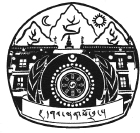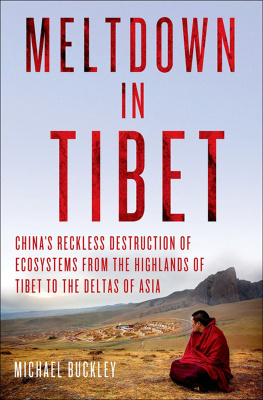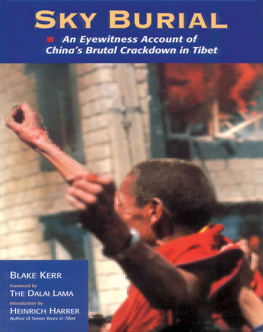Contents
Guide
MELTDOWN IN TIBET
CHINAS RECKLESS DESTRUCTION OF ECOSYSTEMS FROM THE HIGHLANDS OF TIBET TO THE DELTAS OF ASIA
MICHAEL BUCKLEY

The author and publisher have provided this e-book to you for your personal use only. You may not make this e-book publicly available in any way. Copyright infringement is against the law. If you believe the copy of this e-book you are reading infringes on the authors copyright, please notify the publisher at: http://us.macmillanusa.com/piracy.
Abbreviations
| $ | indicates estimated cost in US dollars, converted from Chinese yuan |
| AQI | Air Quality Index |
| CCP | Chinese Communist Party, in sole power since 1949 |
| EIA | Environmental Impact Assessment |
| GW | gigawatt, equivalent to 1,000 megawatts |
| IPCC | UN Intergovernmental Panel on Climate Change |
| MRC | Mekong River Commission, an organization supposed to protect the Mekong Rivers ecosystems |
| MW | megawatt |
| NGO | non-governmental organization |
| PLA | Peoples Liberation Army |
| PRC | Peoples Republic of China |
| TAR | Tibet Autonomous Region, or Xizang, created by Chinese authorities in 1965 |
| UHV | ultra-high voltage power lines, used to transfer electricity from dams to industrial hubs several thousand miles away |

THE DALAI LAMA
PREFACE
T he condition of the river systems on the Tibetan plateau directly impacts the development and even the survival of more than a billion Asians who live downstream. Therefore, it is encouraging to see increasing attention being given to the critical importance of Tibets environment to Asia and the world at large. I welcome Michael Buckleys Meltdown in Tibet as another step in that direction.
Economic development is undoubtedly important for social well-being. Material development enhances societys ability to provide its citizens with decent health and education. In this connection, China has made amazing progress.
However, I believe that pursuing economic development at the expense of the ecological balance will lead to drastic and unforeseen consequences. In the case of China, many environmental experts consider economic accomplishments are already exerting a heavy environmental price. They bemoan the threat of Chinas disappearing lakes, shrinking and increasingly polluted rivers and smog-filled skies that will have long-term consequences for public health. The ability to breathe clean air and drink clean water is a human right. But it is a right threatened by focusing only on economic development that pays inadequate attention to ecological well-being.
As far as Tibet is concerned, there are Chinese scientists who recognize the importance of the plateaus fragile environment, even referring to it as the Third Pole. Therefore, the question of river and water management in Tibet transcends mere political concerns because of its far-reaching impact in this part of the world. This book, therefore, should be part of a wake-up call to the international community and China to seriously assess ecological and environmental conditions on the Tibetan plateau and take remedial measures before it is too late.

July 30, 2014
Why Tibet Matters
G lance at a physical map of the Tibetan Plateau and you will see why the rivers of Tibet are so important to Southeast Asia and the Indian subcontinent. The Tibetan Plateau is the source of the major rivers of this vast region, stretching all the way from the coast of China in the east to Pakistan in the west. Ninety percent of the runoff from Tibetan rivers flows downstream into China, Vietnam, Cambodia, Laos, Thailand, Burma, Bangladesh, India, Nepal, Bhutan, and Pakistan. At the tail end of those same rivers lie the worlds largest deltas. One way or another, close to 2 billion people rely on Tibets watersfor drinking, for agriculture, for fishing, for industry.
Water, not oil, is now becoming the worlds most important resource. Though we live on a planet covered by water, very little of it is accessible. More than 97 percent is seawater, which is too salty: at this point in time, desalination plants are very costly, in terms of both money and energy. Roughly another 2 percent of water resources are locked in ice and snow. That leaves a paltry 1 percent to supply drinking water, grow crops, run factories, cool power plants, and handle all the other key roles that water plays. And its possible that up to half of that paltry 1 percent is polluted or contaminated water, which is not usable. As nonrenewable groundwater resources are used up, the global supply of freshwater is dwindling at an alarming rate. This will lead to great tensions between nations over shared water resources.
Although there is freshwater derived from the ice in the Arctic and Antarctic, most of it cannot be funneled into usable freshwater for human consumption. Tibet is often referred to as the Third Pole, because it is the third-largest source of water locked in ice and snow. Tibet is unique in the world as a mass provider of freshwater, via rivers, to a dozen nations downstream. It is the source of major headwaters for the rivers of Asia and the Himalayas, and additionally provides key tributaries or feeders for other major rivers, such as the Ganges. There is no parallel to this situation anywhere else on the planet.
Tibets glaciers are melting rapidly, and its lakes are drying up. The plateau is under siege from climate-change factors, but instead of seeking ways to minimize the impact of all this, China is aggravating the situation. Chinese hydro consortiums are damming the heck out of the rivers of Tibet, blocking their flows. Extensive mining by Chinese companies is degrading the land, with high potential to pollute rivers downstream. The grasslands of Tibet are being encroached upon by desert.
Why should this matter to someone sitting halfway across the world? Well, for reasons that you will discover in this book, environmental meltdown in Tibet is going to have a huge impact. The initial impact will be on the nations downstream. Any water shortages will disrupt rice or wheat harvests and drive grain prices to record highs, causing great social unrestand causing nations like China or India to import massive quantities of grain.
What appears to be just a Tibetan Plateau problem or a Chinese problem is going to become an Asia-wide problem. Ultimately, this will become a global problem because there are no boundaries when it comes to environmental impact. A volcano erupts in Iceland and spews volcanic ash into the atmospherewhich shuts down flights over the whole of Europe. A tsunami triggers a meltdown at a nuclear reactor in Fukushima, putting Japan on alert for radioactive falloutand leaking radioactive water into the Pacific Ocean, impacting marine life. Massive clear-cutting of forests in Tibet and expanding desertification of grasslands have severely impacted regional ecosystems and may influence extreme weather patterns in Asia. Tibet sits on the largest permafrost layers outside of the two poles. As the permafrost starts to thaw, it releases significant amounts of carbon dioxide and methane into the atmosphere. Methane is a superpotent greenhouse gas, thought to be some 20 times stronger than carbon dioxide.











